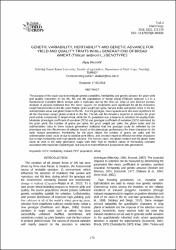| dc.contributor.author | Balkan, Alpay | |
| dc.date.accessioned | 2022-05-11T14:07:13Z | |
| dc.date.available | 2022-05-11T14:07:13Z | |
| dc.date.issued | 2018 | |
| dc.identifier.issn | 1301-1111 | |
| dc.identifier.uri | https://doi.org/10.17557/tjfc.485605 | |
| dc.identifier.uri | https://hdl.handle.net/20.500.11776/5016 | |
| dc.description.abstract | The purpose of the study was to investigate genetic variability, heritability and genetic advance for grain yield and quality characters in the M-2, M-3 and M-4 populations of bread wheat (Triticum aestivum L.) in a Randomized Complete Block Design with 3 replicates during the 2011-12, 2012-13 and 2013-14 periods. Analysis of variance indicated that the mean squares for treatments were significant for all the characters except harvest index in the M-2; plant height, grain weight per spike, harvest index and gluten index in the M-3; sedimentation value and gluten index in the M-4. For the genotype, mean squares were also were significant for all the characters except gluten content in the M-3. The M-2 and M-3 showed a response to selection for grain yield and its components in bread wheat, while the M-4 generation was a response to selection for quality traits. Moderate phenotypic coefficient of variation (PCV) and genotypic coefficient of variation (GCV) estimated for the grain yield, the number of grains per spike, the grain weight per spike, the gluten index and the sedimentation value in three mutant generations indicated that the genotype could be reflected by the phenotype and the effectiveness of selection based on the phenotypic performance for these characters in the early mutant generations. Heritability for the plant height, the number of grains per spike and the sedimentation value could be due to additive gene effects, and selection might be effective for these characters due to high heritability with high genetic advance. The harvest index, the gluten content and the gluten index could be used in the early generation stages with their high to medium values of heritability estimates associated with moderate expected gain, but would be more effective if postponed to late generations. | en_US |
| dc.language.iso | eng | en_US |
| dc.publisher | Soc Field Crop Sci | en_US |
| dc.identifier.doi | 10.17557/tjfc.485605 | |
| dc.rights | info:eu-repo/semantics/openAccess | en_US |
| dc.subject | GCV | en_US |
| dc.subject | heritability | en_US |
| dc.subject | mutant | en_US |
| dc.subject | PCV | en_US |
| dc.subject | population | en_US |
| dc.subject | wheat | en_US |
| dc.subject | Irradiation | en_US |
| dc.title | GENETIC VARIABILITY, HERITABILITY AND GENETIC ADVANCE FOR YIELD AND QUALITY TRAITS IN M-2(-4) GENERATIONS OF BREAD WHEAT (Triticum aestivum L.) GENOTYPES | en_US |
| dc.type | article | en_US |
| dc.relation.ispartof | Turkish Journal Of Field Crops | en_US |
| dc.department | Fakülteler, Ziraat Fakültesi, Tarla Bitkileri Bölümü | en_US |
| dc.identifier.volume | 23 | en_US |
| dc.identifier.issue | 2 | en_US |
| dc.identifier.startpage | 173 | en_US |
| dc.identifier.endpage | 179 | en_US |
| dc.institutionauthor | Balkan, Alpay | |
| dc.relation.publicationcategory | Makale - Uluslararası Hakemli Dergi - Kurum Öğretim Elemanı | en_US |
| dc.authorwosid | Balkan, Alpay/ABA-6059-2020 | |
| dc.identifier.wos | WOS:000457338900013 | en_US |



















